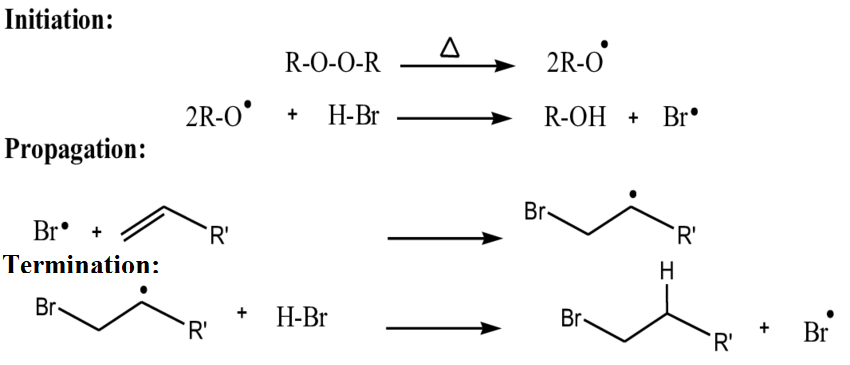
The addition of HBr to an alkene in the presence of peroxide is an example of:
A. Electrophilic addition reaction
B. Nucleophilic addition reaction
C. Free-radical addition reaction
D. Formation of carbocation as an intermediate
Answer
221.1k+ views
Hint: When hydrogen bromide is added to alkenes in presence of peroxide, it reacts with anti-Markovnikov’s addition mechanism. Peroxides form free radicals that initiate the reaction and add bromine radical at terminal carbon.
Complete step-by-step answer:
Peroxides have a weak oxygen-oxygen bond which on heating results in homolytic fragmentation of this bond i.e. the bond breaks in order to leave one unpaired electron on each atom involved in the reaction. Strong sources of light such as floodlight or other source of light radiation which reaches into the near UV might also serve to weaken this bond.
Only a catalytic amount of peroxide is needed to get the reaction started, although one molar equivalent of HBr is essentially required to result in complete addition of HBr to the alkene.
This results in a highly reactive alkoxy radical which then abstracts hydrogen from H-Br, releasing a bromine radical. The bromine radical is the one that is added to the alkene from the molecule hydrogen bromide.
Preferably addition to an alkene tends to occur in such a way that the most stable free radical is formed, tertiary radical here in HBr. That’s the reason that bromine ends up on the least substituted carbon of the alkene. This tertiary radical then eliminates hydrogen from H-Br, liberating a bromine radical, and this way the cycle continues.

Hence, the correct option is (C).
Note: In absence of peroxide, if alkene reacts with hydrogen bromide, the attack of bromine is due to electrophilic addition reaction in which carbocation is formed as an intermediate. It is also called Markovnikov’s addition in which attack takes place on more substituted carbon.
Complete step-by-step answer:
Peroxides have a weak oxygen-oxygen bond which on heating results in homolytic fragmentation of this bond i.e. the bond breaks in order to leave one unpaired electron on each atom involved in the reaction. Strong sources of light such as floodlight or other source of light radiation which reaches into the near UV might also serve to weaken this bond.
Only a catalytic amount of peroxide is needed to get the reaction started, although one molar equivalent of HBr is essentially required to result in complete addition of HBr to the alkene.
This results in a highly reactive alkoxy radical which then abstracts hydrogen from H-Br, releasing a bromine radical. The bromine radical is the one that is added to the alkene from the molecule hydrogen bromide.
Preferably addition to an alkene tends to occur in such a way that the most stable free radical is formed, tertiary radical here in HBr. That’s the reason that bromine ends up on the least substituted carbon of the alkene. This tertiary radical then eliminates hydrogen from H-Br, liberating a bromine radical, and this way the cycle continues.

Hence, the correct option is (C).
Note: In absence of peroxide, if alkene reacts with hydrogen bromide, the attack of bromine is due to electrophilic addition reaction in which carbocation is formed as an intermediate. It is also called Markovnikov’s addition in which attack takes place on more substituted carbon.
Recently Updated Pages
The hybridization and shape of NH2 ion are a sp2 and class 11 chemistry JEE_Main

What is the pH of 001 M solution of HCl a 1 b 10 c class 11 chemistry JEE_Main

Aromatization of nhexane gives A Benzene B Toluene class 11 chemistry JEE_Main

Show how you will synthesise i 1Phenylethanol from class 11 chemistry JEE_Main

The enolic form of acetone contains a 10sigma bonds class 11 chemistry JEE_Main

Which of the following Compounds does not exhibit tautomerism class 11 chemistry JEE_Main

Trending doubts
JEE Main 2026: Application Form Open, Exam Dates, Syllabus, Eligibility & Question Papers

Derivation of Equation of Trajectory Explained for Students

Hybridisation in Chemistry – Concept, Types & Applications

Understanding the Angle of Deviation in a Prism

How to Convert a Galvanometer into an Ammeter or Voltmeter

Degree of Dissociation: Meaning, Formula, Calculation & Uses

Other Pages
NCERT Solutions For Class 11 Chemistry Chapter 7 Redox Reaction

JEE Advanced Marks vs Ranks 2025: Understanding Category-wise Qualifying Marks and Previous Year Cut-offs

Hydrocarbons Class 11 Chemistry Chapter 9 CBSE Notes - 2025-26

Thermodynamics Class 11 Chemistry Chapter 5 CBSE Notes - 2025-26

NCERT Solutions ForClass 11 Chemistry Chapter Chapter 5 Thermodynamics

Equilibrium Class 11 Chemistry Chapter 6 CBSE Notes - 2025-26




